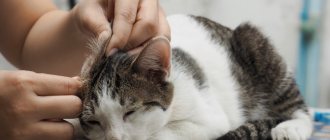The cat scratches itself until it hurts - a moment that should alert the owner. This is especially true for pets who do not have contact with other animals and do not go outside for walks.
Sometimes the owner notices that the pet is constantly itching. This condition is dangerous for the animal, since bleeding scratches often appear at the site of itching. Why does a cat scratch its neck until it bleeds? There are many reasons for this.
The owner should know how to find out what deprives the pet of comfort. The main advice in a situation where a cat scratched its ear until it bled, what to do - observe the animal and show it to a veterinarian to determine the cause of the scratching.
Possible causes of itching
A cat itches a lot if it is bothered by fleas. Even when they are not visible, and the owner is completely sure that all insects have been removed, it should be remembered that the reaction to flea bites lasts up to 1-1.5 months. Be sure to thoroughly check your pet for fleas.
The reasons that cause severe itching in a pet may be:
- helminthiases;
- lichen;
- fungal and bacterial skin infections;
- endocrine diseases;
- hormonal imbalance;
- stress;
- blood-sucking insects and lice eaters;
- allergic reaction to food, care products, cosmetics.
Interesting!
The structure of a cat's brain is much closer to that of a human's than that of a dog. In a cat, the same parts of the brain are responsible for emotions as in a person, so stress in her is caused by the same reasons - humiliation, psychological pressure, undeserved punishment. And stress manifests itself in very similar ways, including skin reactions.
Let's look at the reasons why a cat itches if there are no fleas and methods of treatment.
Treating itching in a cat
For treatment, drugs are used whose action is aimed at eliminating the main cause of the pathological process. Therapy should be carried out with the approval of a veterinarian based on the established diagnosis.
Attention! You should not self-medicate based on your assumptions, since the appearance of a scratch or wound is only a symptom of a concomitant disease.
Basic treatment methods depending on the type of disease:
- Parasitic infections. To eliminate external parasites, the wool is treated with the following types of preparations: Bars, Hartz, Bayer, as well as anti-scabies ointments (ivermectin, aversectin). In case of helminthiasis, Drontal and Prazicide are prescribed. Antihistamines are used to reduce unpleasant itching - Tavegil.
- Fungal pathologies. Bald spots on the neck are treated with Sanoderm and Miconazole ointments, which are used until the pathological signs are completely eliminated. It is also acceptable to use special shampoos such as Sebozol or Nizoral. In particularly difficult cases, the doctor prescribes vaccination using Polivac or Vakderm.
- Bacterial diseases. Antiseptic agents such as Formalin or Miramistin are used to treat wounds. After this, the scratches should be treated with ointments: for dry eczema - naphthalene or Vishnevsky, for wet eczema - Lassara or zinc. To eliminate bedsores, Levomekol ointment is prescribed.
- Allergic reactions. Antihistamines are prescribed: Stop-itching, Suprastin, Tavegil.
Be sure to read:
Why does a cat constantly scratch its chin: what kind of disease is it?
Depending on the severity and form of the pathology, the doctor may also prescribe immunomodulators, antibiotics, gastroprotectors, probiotics and other types of medications.
Itching caused by helminths
Helminths in cats
Helminths not only have a pathological effect on the cat’s digestion. Worms cause loss of essential nutrients by absorbing micronutrients from the intestines. As a result of lack of nutrition, the pet's skin becomes dry, dandruff appears, and the cat licks itself much more often and more intensely, trying to get rid of the itching.
Intoxication of the animal's body with waste products and toxins produced by worms provokes an allergic reaction, skin rashes, and itching. Even a tiny kitten can suffer from helminthiasis after acquiring parasites from an adult cat. Therefore, if the kitten is itching, it is necessary to check its feces for the presence of worm eggs. The area around the anus may also itch when helminths crawl out to lay eggs. The cat then behaves characteristically - it “rides” on the carpets with its butt, relieving the itching.
Interesting!
There are 3 types of helminths parasitizing the body of cats:
- roundworms;
- tapeworms;
- flukes.
Some species are transmitted through flea bites to humans. The presence of worms in kittens leads to delayed growth and development, and in pregnant cats, worm infestation can cause miscarriage. In the presence of individual individuals in the body, the disease can be asymptomatic. Fleas also transmit helminthiasis to other pets, so all inhabitants of the house need to be treated.
Medicines for helminths
If the itching is caused by worms, then it is necessary to deworm the animal. For this purpose, as prescribed by the veterinarian, the animal is given Prasitel, Pyrantel, Trontsil K, Kanikvantel, Profender, Polyvercan (sugar cubes), Panacur, Febtal, Dirofen, Milbemax, Drontal. But first you should undergo an examination and determine the type of parasite, since broad-spectrum drugs are much more toxic than those that act selectively.
Ringworm and other types of skin mycoses
The reason why a cat itches, but there are no fleas, may be various fungal skin infections. Dermatomycosis is a common and diverse pathology in cats. They are caused by molds and yeasts. In weakened animals and kittens, progressive mycosis can lead to death.
Dermatomycosis in cats is a poorly studied group of diseases. The most famous is trichophytosis or ringworm:
- When the disease occurs, areas with lost hair form;
- the pathology is accompanied by the formation of abundant dandruff and severe itching, in which the cat scratches the affected area until sores appear;
- Many types of mycosis are transmitted through the bites of blood-sucking insects.
A sick pet can infect its owner. Young children who, due to insufficiently developed immunity, lack protection against fungi are especially at risk.
Ringworm in cats
All types of cats are susceptible to skin fungal pathologies. But veterinarians note that Persians are especially prone to fungal infections.
If scratching or areas of hair loss, especially clearly limited ones, appear, you should consult a doctor, since only with the help of microscopy can you determine the type of pathogenic fungus and determine how to treat it.
Therapy for mycoses involves drugs from the griseofulvin group, vaccination and the use of external antifungal agents. Itching can be treated using symptomatic external remedies. A cat itches as long as there is an irritating factor - it will disappear and the pet will not itch.
Diagnosis of the condition
An unpleasant sensation that causes a strong desire to scratch is itching. This condition in an animal is an obvious sign of skin damage. In veterinary medicine, there are 2 types of disorders:
- Localized type, when one or several places on the pet’s body begin to itch. Sometimes scratches appear only on the face, as well as on the neck and cheeks.
- Generalized type, which involves the appearance of sores on the entire body of the animal.
If you notice that your cat is itching a lot and drops of blood appear in the scratching areas, you need to contact a specialist at a veterinary clinic. To begin with, the pet is examined for the presence of blood-sucking parasites, which can cause severe stress in both couch potatoes and walking individuals. Scratch marks from bites are most often found on the chin, cheeks, neck, and tail. If fleas or ticks are not detected, then we are talking about other, more serious reasons.
After questioning the owner, the doctor will scrape the damaged area on the pet’s skin. Examination of the sample in the laboratory helps to identify the causative agent of the disease. Additional tests may also be ordered.
Once the exact disease is determined, the veterinarian prescribes treatment and gives additional recommendations on nutrition and care for the recovering patient.
Unfortunately, owners go to the veterinary clinic too late: when they discover severe wounds, bleeding scratches or bald patches on the pet’s body. This is the next stage of the pathology, which causes severe discomfort and can lead to severe infection. The duty of a good owner is to notice and respond to the problem in a timely manner.
Infectious skin diseases
Itching in an animal can be caused by an infection that has penetrated into the thickness of the skin through scratches, small wounds, or flea bites. Local inflammation causes the cat to itch furiously, but bacterial infections can be treated well. Veterinarians advise using sulfur ointment or Juglone powder externally. These drugs cope equally well with dermatomycosis and bacterial infections. Systemic treatment may require antibiotics, but these medications should only be given to your pet as directed by a doctor.
Interesting!
Juglone powder, dissolved in an oil base, was rubbed into the skin for ringworm behind the cat's ear. After a few days, the lesion shrank, and after a week of use it disappeared completely. Juglone is a black walnut extract that is used in America to treat parasitic diseases. The drug has a bactericidal, sedative, antifungal, antiprotozoal and immunomodulatory effect. According to expert reviews, the product copes well with skin problems in animals. We have only recently begun to treat dermatoses with this medicine, and the drug is difficult to find on the market.
Juglone
Infectious skin lesions in cats are secondary and are not transmitted to humans. Most often, people are the source of infection for cats.
Infestation by exogenous insects
A cat can itch even in the absence of fleas; in addition to them, other arthropods can parasitize the pet. External parasites cause various diseases in cats, the most dangerous of which are:
- damage to the ear by ear mites;
- sarcoptic mange, which is localized in various parts of the body;
- notoedrosis, which most often manifests itself in the muzzle area.
Treatment for ticks, lice eaters, and fleas involves the use of special products—drops, sprays, and shampoos. They help not only remove fleas and other parasites, but also relieve itching.
Treating scratches at home
When it is not possible to quickly contact a veterinarian, the pet still needs help. If you do nothing, the situation begins to worsen, and the sores become very painful. You can understand that the pathology is becoming more complicated by the cat’s reaction - he tries to hide and does not allow the sores to be examined.
Another dangerous factor is the risk of infection of the sores. This leads to irreversible consequences and even death. This happens due to ignoring the pathology, as well as improper treatment. Therefore, if you find a sore or scratch, you should not immediately smear it with human products - it is better to observe your pet and then consult a doctor.
Sometimes the owner cannot quickly take his mustachioed friend to the hospital, but the doctor is able to prescribe medications over the phone. This will help somewhat reduce discomfort and remove the threat of the disease spreading throughout the body. It is important to remember that this does not cancel a visit to the clinic, but only provides a temporary relief effect.
The formation of abscesses and abscesses requires surgical intervention. The doctor promptly removes pus from deep wounds and washes them. Non-steroidal anti-inflammatory drugs are then prescribed to restore the patient's weak immune system.
If the inflammation is not very extensive and does not provoke severe pain, then treatment at home is more like preventive measures. If there is no infection, the wounds begin to heal within a couple of days. To disinfect and relieve discomfort, sores are wiped with calendula tincture or hydrogen peroxide. You should not use alcohol solutions, because they will cause even more harm to the cat’s skin. It is best to buy a herbal mixture at the pharmacy and prepare the infusion yourself according to the instructions.
Allergic reactions
Allergies in cats can be caused by various factors:
- feed;
- anti-flea collar;
- flea remedies;
Allergy to flea drops - medicines;
- pollen, dust, etc.
Only a veterinarian can determine the allergenic factor and prescribe treatment. Often it is flea collars that cause contact dermatitis, causing hair loss, itching, and scratching of the neck area. The owner needs to carefully monitor how the animal reacts to changes in the diet or the use of new products for caring for the pet’s fur and skin.
A cat can also itch due to systemic pathologies. With endocrine diseases, the cat begins to scratch the area of the neck, ears, and back. The cat's spine is very flexible, so the pet begins to scratch hard-to-reach areas, which leads to sores. Untreated allergies can lead to angioedema and death of the animal.
There are many reasons why a cat starts to itch. When a cat occasionally scratches itself, this is the norm for cats, but when an animal scratches and licks a certain area until wounds and sores form, you should immediately contact a veterinarian to avoid serious consequences for the pet’s health.
Symptoms and diagnosis of why a cat itches
The general condition of the sick animal is depressed; when licking and scratching the ulcers, the animal may meow pitifully.
Many pathologies can cause annoying itching. But at the same time, you should not confuse the daily combing and licking of the animal, which he does for hygienic purposes.
Alarming symptoms:
- the pet itches constantly, scratching the skin to the point of wounds;
- bald patches appear;
- the pet behaves aggressively;
- the fur falls out in clumps;
- appetite decreases;
- the eyes turn sour;
- ulcers and erosions form;
- dandruff appears.
If painful signs appear, you should contact your veterinarian. Only a specialist can determine the root cause of itching.
Diagnostic methods:
- visual inspection of the cat;
- bacterial culture;
- blood test to identify the allergen;
- cytological examination of skin tissue, which allows us to identify the functionality of cellular elements;
- skin scraping, eye wash, ear and nose swab.
Depending on the data received, the doctor makes a diagnosis and prescribes appropriate treatment. Self-medication is not recommended, as this will not only not help the pet, but will also significantly complicate the situation.











